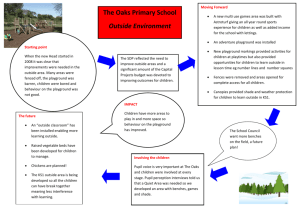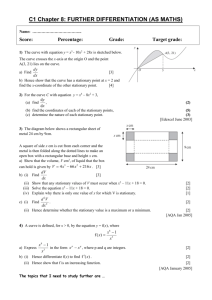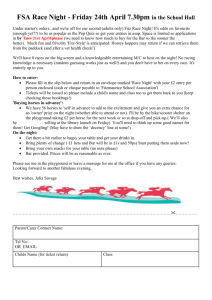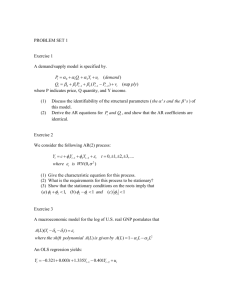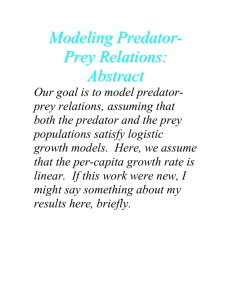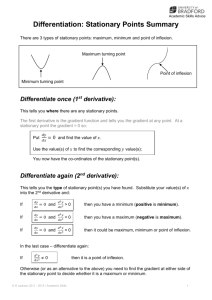SACERS Questions
advertisement
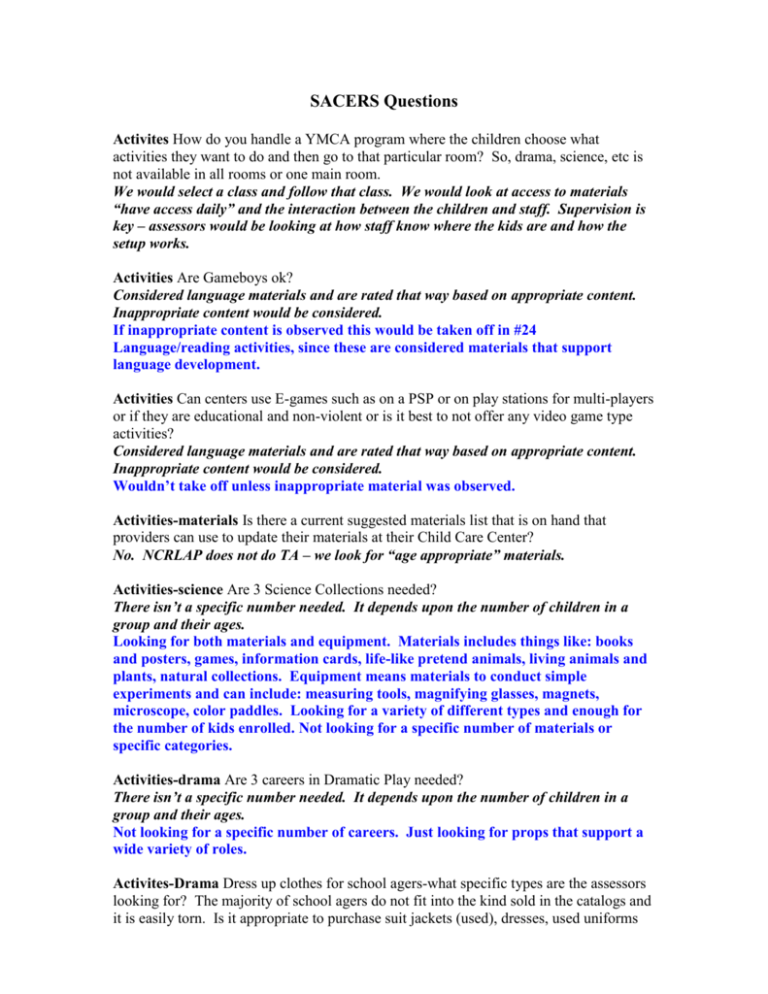
SACERS Questions Activites How do you handle a YMCA program where the children choose what activities they want to do and then go to that particular room? So, drama, science, etc is not available in all rooms or one main room. We would select a class and follow that class. We would look at access to materials “have access daily” and the interaction between the children and staff. Supervision is key – assessors would be looking at how staff know where the kids are and how the setup works. Activities Are Gameboys ok? Considered language materials and are rated that way based on appropriate content. Inappropriate content would be considered. If inappropriate content is observed this would be taken off in #24 Language/reading activities, since these are considered materials that support language development. Activities Can centers use E-games such as on a PSP or on play stations for multi-players or if they are educational and non-violent or is it best to not offer any video game type activities? Considered language materials and are rated that way based on appropriate content. Inappropriate content would be considered. Wouldn’t take off unless inappropriate material was observed. Activities-materials Is there a current suggested materials list that is on hand that providers can use to update their materials at their Child Care Center? No. NCRLAP does not do TA – we look for “age appropriate” materials. Activities-science Are 3 Science Collections needed? There isn’t a specific number needed. It depends upon the number of children in a group and their ages. Looking for both materials and equipment. Materials includes things like: books and posters, games, information cards, life-like pretend animals, living animals and plants, natural collections. Equipment means materials to conduct simple experiments and can include: measuring tools, magnifying glasses, magnets, microscope, color paddles. Looking for a variety of different types and enough for the number of kids enrolled. Not looking for a specific number of materials or specific categories. Activities-drama Are 3 careers in Dramatic Play needed? There isn’t a specific number needed. It depends upon the number of children in a group and their ages. Not looking for a specific number of careers. Just looking for props that support a wide variety of roles. Activites-Drama Dress up clothes for school agers-what specific types are the assessors looking for? The majority of school agers do not fit into the kind sold in the catalogs and it is easily torn. Is it appropriate to purchase suit jackets (used), dresses, used uniforms (work related), and any multicultural items that can be found at a reasonable price? Is it appropriate to have used ladies shoes such as high heels? We are looking for a choice for each age group of children. We are not looking for any particular type of dress up. Looking for a variety of props. Second hand grown up clothes are fine. Activitites-Books Pictures in encyclopedias that depict violence-such as pictures of Hitler? Should these be removed? What about pictures in books that the children bring to the site with them such as their history books for homework? Or a book that has been assigned for them to read from one of their classes? We can take the violence out of the book center but it is impossible to control what is brought in with the students. We would look at the book center to see what resources the program has there. Programs have no control over what is assigned for homework. Books with this type of content must be homework specific. We would look at space and whether the area is a quiet environment and whether there is a requirement to complete homework. We are not looking at homework content or encyclopedias and other reference books that are in a reference book section. We are considering all books, even reference type books, if they are mixed in with the other books intended for general reading. Activities-Construction Does a small assortment of screwdrivers and screws with some soft wood count as functional carpentry tools in the block center or does it need to be a “woodworking center” complete with saws and hammers? Not required to be in block center. Could be a special activity available on a “regular” basis. Does not have to be available every day. Looking to see that children can do actual construction with wood, and some kind of tools. Don’t require specific materials. A screw driver and screws would be sufficient if the wood really was soft enough for children to build that way. This would require pretty soft wood to allow that without a drill. Hammer and nails are the most common materials, but this does require safety provisions like goggles and enough supervision to make sure that it happens safely. Don’t need a saw. Space #4 homework I have a lot of centers that do homework as a group so they don’t have a designated space for homework because all the children are at the tables. Will they score a 1 on room arrangement on 4a, because there is not a separate area just for homework If the only activity is homework, they have designated space…just no free choice if children have other options. In programs where children are required to do homework, this is not free choice. Space #4 homework What if homework is not part of the schedule but they do allow children to do if they want to? Are they still required to have a separate, quiet space for homework? Same standards apply. Quiet space is needed for them to have homework regardless if it is on the schedule. Assessors will “score what they see”. Any place where children are doing homework should allow them to be away from distracting play activities and quiet enough so that they can concentrate. In the inadequate and minimal levels (1.4 and 3.4) a separate area for homework just means a table where other play activities do not take place. In the good level (5.5) the space provided for homework also needs to be quiet, so that children are not distracted by noisy play. Space-#4 homework If homework is on the schedule as free choice, does it still need to be quiet? Yes. A quiet area is needed. Misc-homework Is assigned seats during homework ok? Yes, it’s fine. But, the assessors will look at how controlling the program is overall. The children should be moving around “freely”. If children are kept together as a group for long periods of time and are not able to select their own companions and activities this will affect a number of different items. However, assigning seats for brief activities will not affect any items, as long as the activity itself is voluntary. (Items affected: #3, #33, #37, #38). Space #9 Please define shared space and dedicated space Shared Space – others using space and putting out or up their own materials. An example would be More At Four using same space as after school program. Dedicated Space – The primary purpose is for use of school age program. Space can be used by others on a limited basis such as Occupational/Physical therapist session. Exclusive Use of Shared Space – If other children use materials at limited times. School based programs usually have dedicated space because both are not operating at the same time. Day care programs usually have shared space because they are operating other parts of their program at the same time. This refers to the playground. If the playground is used by both the host facility and the AS program, the playground in a school based program is considered dedicated space because the school and the afterschool programs operate at different times. The playground in a center based program is not considered dedicated because the pre-school program and the after-school program operated at the same time and are still “sharing” the space and the after-school program has to arrange for use of space—especially during full-day program times. For more information, see the NCRLAP website additional notes. Space #9 I have a number of programs that share the More@4 room with the schoolagers as well as the playgrounds. More@4 is not there during the time when the school age program is using the space. Does this mean they will score a 1 on Access to Host facilities, because school age program does not have space dedicated just to them? It is possible for after school programs to have both shared space and dedicated space. Depends on whether the MAF program is housed in a school or a center. When a program is in a school the playground is considered to be dedicated space if no one else uses the space while the SA program is using it, even if that space is used by other groups at other times. In a center then they would score a 1 because they have no space that is primarily for them. Space #9 How do you handle a situation where a school stores portable bleachers and the lost and found area in the multipurpose room which is the area that becomes the space for the after school program? As long as the SA program’s use of the space is not limited by this the space is considered dedicated space. Space #9 If an after-school program shares its space with a part day morning preschool does that count as shared space even though they aren't both there at the same time? What about More at 4? This would be considered exclusive use of shared space, rather than dedicated space. Shared space. If a program serves both preschool and school age children in the same classroom area, we will use the scale that has the majority of children. This refers to the situation where the pre-school and school age kids are in the same space at the same time. This was a different question about different ages at different times, similar to the question about the MAF program. GM-equipment What would be considered stationary equipment outside besides the normal swings, slides, etc? Many times the equipment is okay for the younger a/s children but not the older. I was wondering if a horseshoe pit or balance beam would be considered stationary or a volleyball or badminton area with poles. I'm assuming a basketball goal that is permanent(in the ground) would be stationary but what about one that stays outside but could be moved? Equipment is portable if an adult can easily move it. Portable is “can be made available – can be moved around”. Stationary equipment is always there – it is considered permanent. Painted on games such as hopscotch, etc. where equipment is there also is considered stationary. GM-equipment What should a center do if they do not have any stationary playground equipment? They will score low no matter how much portable equipment they have purchased. There are conditions in most programs that are out of the control of providers. If there is no way to meet that particular need then the program can focus on excelling in the areas that they can control. It is the overall score that is associated with good developmental outcomes, not the score for any particular item. See if they can work with the host facility to provide something. Paint it on. Equipment can count as stationary even though they are not anchored as long as they are big and heavy enough so that children cannot move them. For example, the lightweight plastic basketball hoops that children can move are not stationary, but the heavier ones (often have a base that can be filled with sand) that children cannot move are stationary (might not be age appropriate for older children, depending on their size). There will shortly be a change in the additional note for this indicator to clarify the definition of “stationary”. GM-equipment Are fuse-ball tables appropriate activities? They can promote social skills, counting, math and number activities. Considered stationary gross motor equipment Fuse-ball tables are considered GM equipment because they encourage use of large muscle groups. If children were observed keeping score this would be counted towards use of math in everyday activities. If this is a free choice activity where children can choose their companions that will also count in those items. GM-space If a program has 100 children (4 classes) K-5th on the playground at the same time how will that effect the scales? If ages are separated and using the playground at different times, it is ok. Item 2 indicator 7.3 requires that younger and older children are separated. The additional note defines appropriate groups as: K-3, 4-6, and other. In the situation that you describe these requirements would not be met if all children used the same gross motor space at the same time. Supervision Please define when the bathroom door can be closed and when it can be open a small crack. The older children have an issue with privacy with the older boys in the room with the girls. This is not an issue with the younger children but around the age of 11 or 12, they like to have the door completely closed. If in the classroom, not required to be open. We are looking for no more than one child at a time and the teacher is aware of the child being in the bathroom. Supervision is key. If there is a requirement in the scale for an adult only bathroom and the kids use this bathroom, you won’t get scored well on this. This is a supervision issue. As long as supervision is provided to keep children safe then children do not need to be visible at all times during the toileting process. Issues would be: Is more than one child in that space? Where is the space located? How long are the children not visible? Is the teacher aware that the child is in that space? Procedures-attendance If a center operates a second shift and those children start to come in during the hours of operation of the first shift but the center never goes out of ratio and the teachers have a clip board of the children present, will this affect their score? We don’t look at ratios. We look at adequate supervision and whether there are enough teachers to supervise children. For arrivals, children’s names must be on attendance sheet. For departures, a signature of person is needed for adults picking up children. Procedures If the teacher is the van/bus driver, and is not in the room when the assessor arrives, but is there when the first group of children arrives, because he/she is bringing them, is this an issue? Yes, because of teacher interview that must occur as a part of pre-assessments. However, the assessor can do the interview at the end if this is the provider’s preference. Procedures-schedule The children in a school a/s program must gather in classrooms to wait for 10-15 minutes before going to their space which is the multipurpose room, which is used for the gathering and dismissal of bus students. The go in as the last students get on their buses. When does your assessment start and where? Our observation begins when children are considered to be out of the care their classroom teachers, and in the care of the AS program. So if children are in the care of the AS staff while they wait to go to the multi-purpose room then that is considered observation time. Procedures-Contact for questions Is there an email address or someone that we can easily contact with a question or two when it arises? You can contact Nansi White at ncwhite2@uncg.edu Procedures-staff If volunteers are in the program every day, are they considered in ratio or how are they looked at in relation to program staff and requirements? See the definition of staff in the general notes. If a person is in the classroom every day on a regular basis, they are considered staff. Procedures If a site has only 3 or 4 children, can they share a room with the 4 year olds or must they have a separate space. If they are assessed, should they have a separate space for these 4 children because this will severely impact their score otherwise? We will use the scale that pertains to the majority of children in the classroom. During the day at some point there has to be at least one more than 50% of the children that are typically there. Procedures If most of the children are gone by a certain time of the day, will the center still be assessed in the SACERS? For example if the majority of children are gone by 5:15, will the center still be assessed in SACERS? The site serves children ages 0-12. A valid assessment requires 2 hours. There is no assessment for less than 2 hours. In order to be able to conduct a valid assessment we must be able to observed children in attendance for at least 2 hours. And at sometime during that observation at least one more than 50% of the children must be present. Misc.weather permitting When answering “when do you NOT play outside” and the teacher answers during the code red, purple or orange ozone days according to sanitation guidelines, this is a conflict with NC DCD licensing rules even though SACERS wants children to go outside every day “weather permitting” Children are not required to go outside when it is actively raining, snowing, or during weather advisories. The time of day or hours attached to the weather advisory is also taken into consideration. Misc-lesson plans. How detailed must the lesson plans be written? None of the scales require lesson plans. Misc. With the addition of extra assessors to meet the need of the assessments required for the new 2 component DCD licensure system, is there a system in place to ensure reliability in the scoring of a facility? Not just in the actual scores on each indicator but is there a system used (such as an Excel spreadsheet with formulas) to compensate for human addition errors when calculating the center’s final scores? It is a very involved training process and the staff continue to be supervised on a continual basis to verify reliability. All assessors are rigorously trained on just one scale when they join the project and are not permitted to conduct independent assessments until they have demonstrated that they are consistently reliable on the scale they will be using. For the first 6 months assessors are re-checked every 6-10 assessments, and all staff are checked on a regular basis forever. The score sheets are done the old fashioned way. During the process of editing the AR the score sheets are checked for accuracy by 2 people in addition to the assessor, but mistakes do occur. Feel free to double-check the math. Encourage your providers to ask questions about any of the information in the AR that they do not understand or agree with, or to bring math errors to our attention. We want AR’s to be accurate. Misc.-scoring How are the scores added? Is this manual tabulation or by computer formulation on a spreadsheet? Currently adding up scores with calculators. In the future, the plan is for the NCRLAP website to have the capability to calculate scores for NCRLAP staff. Misc. scoring Is it still correct that Items #12 and #14 are not scored? Yes Misc. When will SACERS be revised? And will there ever be an All About SACERS and a video available? The last meeting I had with Debbie Cryer she indicated that now they have finished the FDCRS revision, they will turn their attention to the SACERS. There is no time line on that. Additional Questions: If a program cannot put stuff on walls, what can they do? Children created work must be displayed. Programs should come up with ideas to display work. Examples include hanging sheets, string and clothes pins, portable display boards, etc. In a program where teachers stand in the hallway between 2 rooms, how many areas does that hit? Hugh numbers as there are no interactions with children. This situation can affect the language, activity, teacher/child interaction, supervision, and discipline items. There is a change in the requirement for sanitizing solutions. Make sure when the tables are sprayed with a bleach/water solution that the solution must be on the table for 2 minutes before removing. Other germicides and sanitizers must be used according to product directions. This can be longer than 2 minutes. Are programs assessed before school? We would only do this if it was the only time they could be assessed. How will it be scored if a program has military men figures? We are not monitoring violence within one cultural group. We would be taking off for violence between distinctive ethnic groups such as Cowboys and Indians.



